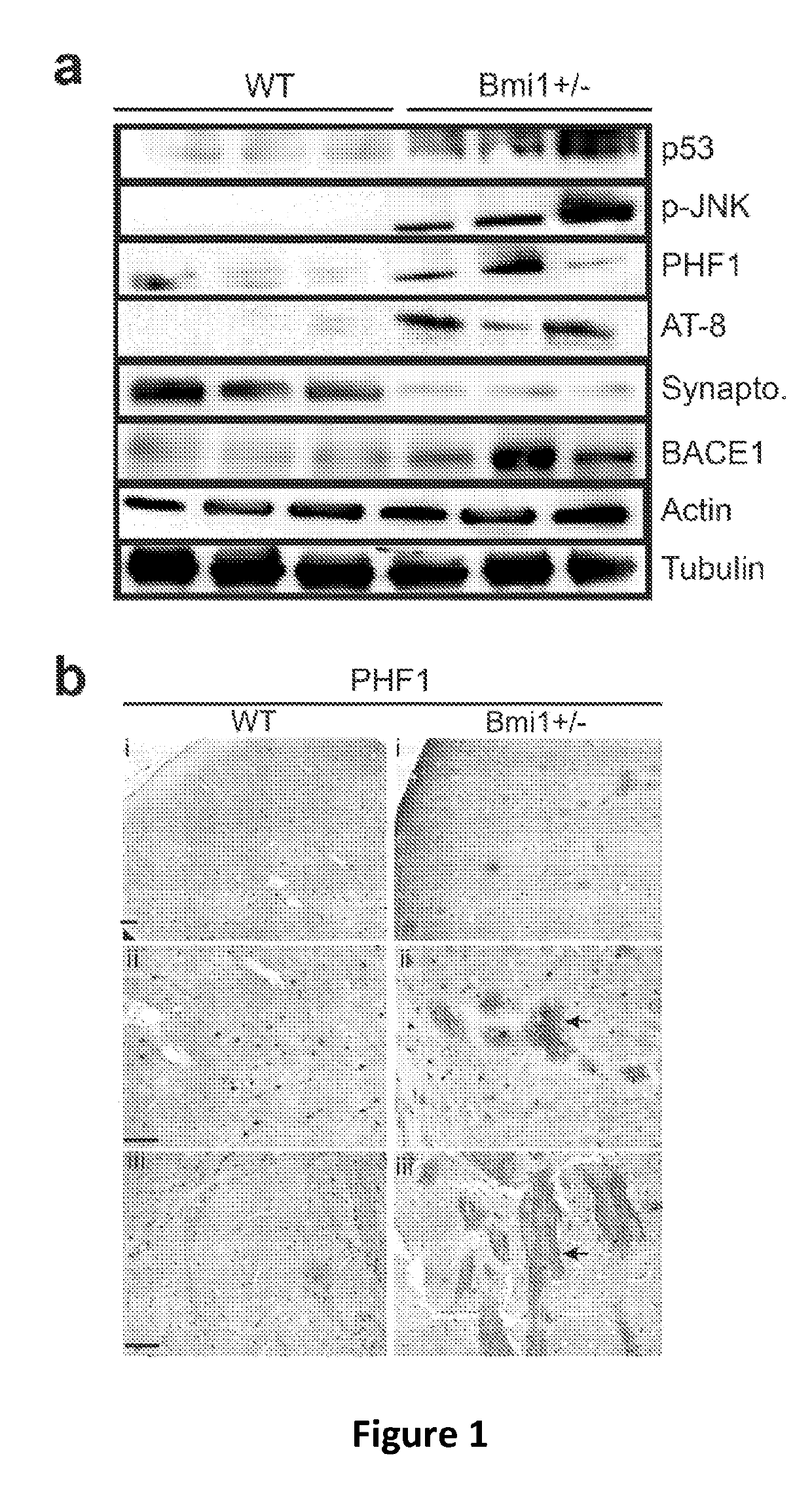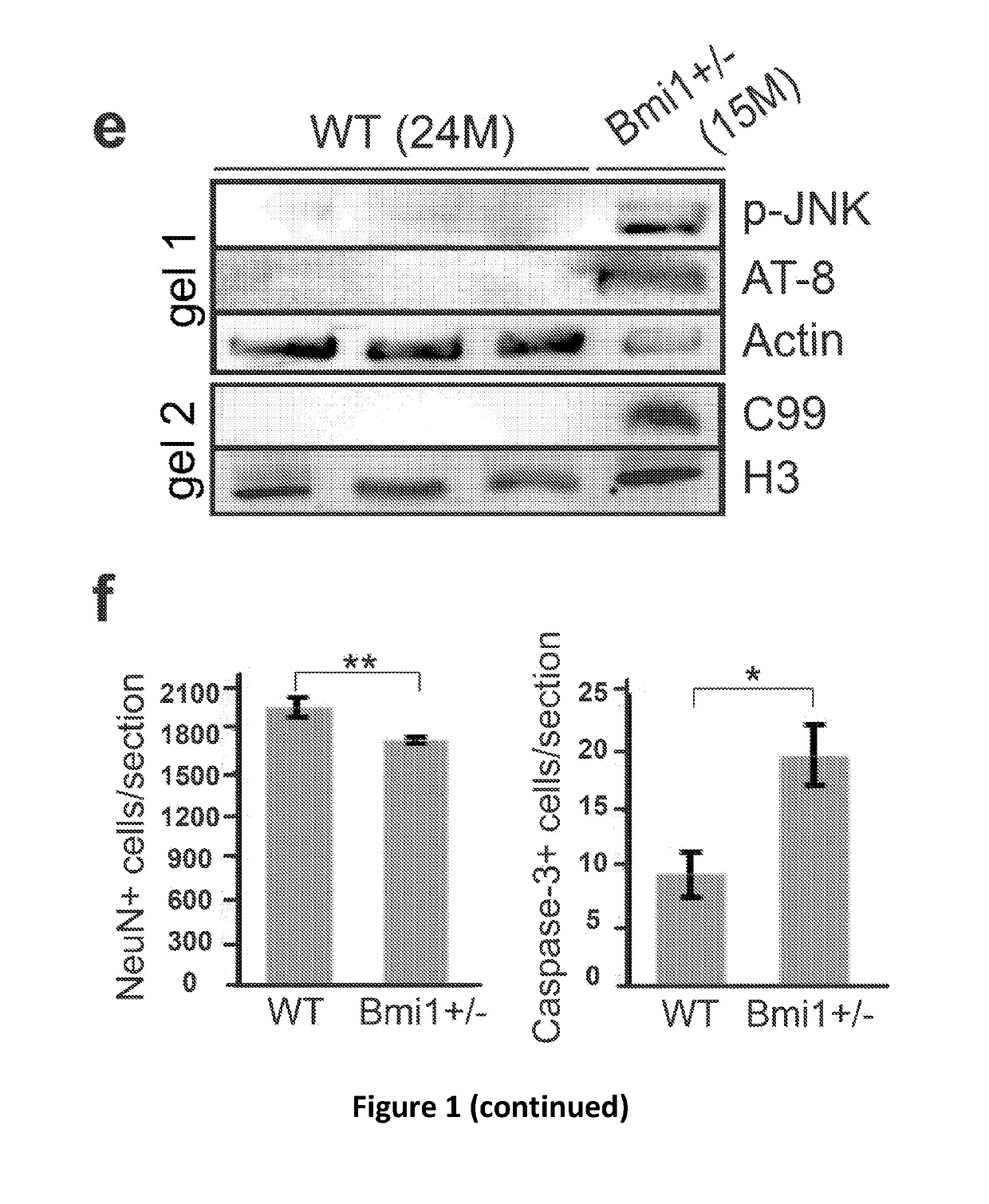Cortical neuron cell model of alzheimer's disease based on bmi1 deficiency, and uses thereof
a cortical neuron and alzheimer's disease technology, applied in the field of dementia-related neurological diseases, can solve the problems of not being able to direct the screen toward novel ad-mediation pathways, unable to stop or delay sad disease treatment, and unable to achieve the effect of accelerating the progression of sad, and reducing the risk of death
- Summary
- Abstract
- Description
- Claims
- Application Information
AI Technical Summary
Benefits of technology
Problems solved by technology
Method used
Image
Examples
example 1
iation of Human Embryonic Stem Cells into Cortical Neurons
[0112]Human embryonic stem cells were differentiated into cortical neurons. The differentiation protocol was based on a previous study (Espuny-Camacho, I., et al., Pyramidal neurons derived from human pluripotent stem cells integrate efficiently into mouse brain circuits in vivo. Neuron 77, 440-456, (2013)). However, the Noggin agonist LDN193189 was used to reduce recombinant Noggin concentration. The H9 (WiCell™) and HUES9 (Harvard Stem Cell Institute) cell lines were dissociated using Accutase™ (Innovative Cell Technology #AT-104) and platted on growth factor reduced Matrigel™ (Corning #356231) in PeproGrow™ hES cell media (PeproTech #BM-hESC) supplemented with ROCK™ inhibitor (Y-27632; 10 μM, Cayman Chemical #10005583). Upon 70% of confluency, the media was changed to DDM supplemented with B27 (1× final), Noggin (10 ng / ml, PeproTech #120-10C) and LDN193189 (0.5 μM; Sigma #SML0559). The medium was changed every day. After 1...
example 2
zygous for Bmi1 Develop AD Pathology with Age
[0115]The AD-like brain (cortex) pathology of 15-24 month old Bmi1+ / − mice compared to WT littermates. FIG. 1 reveals that p-Tau, C99 fragment and amyloid plaques accumulation, neuronal loss and synaptic atrophy in Bmi1+ / − mice. These are recognized hallmarks of AD.
example 3
tivation in Human Neurons Induces a Gene-Expression Signature Related to AD
[0116]To test if BMI1 deficiency in human neurons could result in a similar neuropathology, we inhibited BMI1 activity in cortical neurons produced from the differentiation of human embryonic stem (hES) cells {Espuny-Camacho, 2013}. After 24 days of neural induction, progenitors were dissociated and infected with a lentivirus expressing a small hairpin RNA (shRNA) with a scramble sequence (shCTL+Hygro- / GFP) or an shRNA directed against BMI1 (shBMI1+Hygro / GFP), prior to differentiation in post-mitotic neurons (FIG. 2A-C) {Abdouh, 2009}. After 14 days, the majority of cells were positive for the anterior neural / cortical marker FOXG1, the pan-neural markers b-III-tubulin, MAP2 and NeuN, and the glutamatergic and GABAnergic neural markers vGLUT1 and GABA, respectively (FIG. 2D-G). Morphometric analyses using the PMI index revealed that ˜60% of bIII-tubulin neurons were cortical pyramidal neurons (FIG. 2H) {Espuny...
PUM
| Property | Measurement | Unit |
|---|---|---|
| dimensions | aaaaa | aaaaa |
| chemical structure | aaaaa | aaaaa |
| soluble fraction | aaaaa | aaaaa |
Abstract
Description
Claims
Application Information
 Login to View More
Login to View More - R&D
- Intellectual Property
- Life Sciences
- Materials
- Tech Scout
- Unparalleled Data Quality
- Higher Quality Content
- 60% Fewer Hallucinations
Browse by: Latest US Patents, China's latest patents, Technical Efficacy Thesaurus, Application Domain, Technology Topic, Popular Technical Reports.
© 2025 PatSnap. All rights reserved.Legal|Privacy policy|Modern Slavery Act Transparency Statement|Sitemap|About US| Contact US: help@patsnap.com



